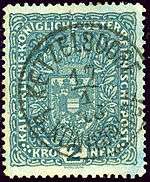Dvůr Králové nad Labem
| Dvůr Králové nad Labem | |||
| Town | |||
 | |||
|
|||
| Name origin: Queen consort's court on the Elbe | |||
| Country | Czech Republic | ||
|---|---|---|---|
| Region | Hradec Králové | ||
| District | Trutnov | ||
| Commune | Dvůr Králové nad Labem | ||
| River | Elbe | ||
| Elevation | 298–482 m (978–1,581 ft) | ||
| Coordinates | 50°25′59″N 15°48′44″E / 50.43306°N 15.81222°ECoordinates: 50°25′59″N 15°48′44″E / 50.43306°N 15.81222°E | ||
| Area | 35.82 km2 (13.83 sq mi) | ||
| Population | 16,282 (2010-12-10) | ||
| Density | 455/km2 (1,178/sq mi) | ||
| First mentioned | 1270 | ||
| Mayor | Ing. Jan Jarolím (ANO 2011) | ||
| Timezone | CET (UTC+1) | ||
| - summer (DST) | CEST (UTC+2) | ||
| Postal code | 544 01 - 544 04 | ||
  Location in the Czech Republic | |||
| Wikimedia Commons: Dvůr Králové nad Labem | |||
| Statistics: statnisprava.cz | |||
| Website: www | |||
Dvůr Králové nad Labem (Czech pronunciation: [ˈdvuːr ˈkraːlovɛː ˈnad labɛm], German: Königinhof an der Elbe) is a town in the Czech Republic in Hradec Králové Region, in the Labe (Elbe) river valley. It is located in the Eastern Bohemia close to the Czech highest mountains Krkonoše.
Features
Dvůr Králové is a center of the textile and machinery industries.
Dvůr Králové Zoo with its African safari theme lies near the town. Visitors may admire well over 2000 animals of 500 species of mostly African hoofstock which makes this zoo one of the largest in Europe. As one of the most successful breeders of many endangered species it is of note that within the last 30 years more than 200 giraffes were born there.
Outside the city, visitors can view an old residence of the Jesuits in Žireč and a hospital in Kuks, both with many Baroque statues by famous sculptor Matthias Braun.
History
Bohemia
Dvůr Králové was first mentioned in 1270. It was a dowry town, owned by the King's wife and responsible for her expenses when her husband died. Until 1918, the town was part of the Austrian monarchy (Austria side after the compromise of 1867), head of the Königshof an der Elbe - Dvůr Králové nad Labem district, one of the 94 Bezirkshauptmannschaften in Bohemia.[1]

Textile Industry
Dvůr Králové allowed Jews to settle there in 1848. Various Jewish families arrived in the early 1860s and began developing a local textile industry (the soft water of the Elbe was essential for the dying and printing for the textile industry). By 1930 there were some 200 to 300 Jews living in the town. The textile industry had grown to some 17 textile firms (Sohorts, Neuman, Mautner, Deutsch etc.) By the end of 1945 there were no Jews left in the town.
Manuscript affair
On 16 September 1817 Václav Hanka allegedly discovered a manuscript appearing to be from the 13th century in the tower of a local church. The Manuscript of Dvůr Kralové, probably in fact created by Hanka, was intended to help Czech patriots in the struggle against German culture. It was proven to be a forgery at the end of the 19th century by Professor Tomáš Masaryk and confirmed as such by later examinations.[2] A minority of historians still consider it genuine.
Twin towns — sister cities
Dvůr Králové nad Labem is twinned with:
-
 Piegaro, Italy
Piegaro, Italy -
 Verneuil-en-Halatte, France
Verneuil-en-Halatte, France -
 Cedar Grove, New Jersey, United States
Cedar Grove, New Jersey, United States -
 Kamienna Góra, Poland
Kamienna Góra, Poland
See also
- Otto Gutfreund
- Josef Král
- Martin Šonka
- Franz Pacák
- Georg Pacák
- August Stauda (1861, Žireč (German: Schurz) - 1928, Vienna), photographer, documentarist of "alt Wien"
- Michal Súkup
- Johann Wolschik (1850-1921) Bohemian pioneer/immigrant into southern Brazil, was born in Königinhof am der Elbe.
References
- ↑ Die postalischen Abstempelungen auf den österreichischen Postwertzeichen-Ausgaben 1867, 1883 und 1890, Wilhelm KLEIN, 1967
- ↑ http://kix.fsv.cvut.cz/rkz/
External links
| Wikimedia Commons has media related to Dvůr Králové nad Labem. |
- Dvůr Králové on a map
- ZOO Dvůr Králové
- Dvůr Králové a okolí
-
 "Königinhof". Encyclopædia Britannica (11th ed.). 1911.
"Königinhof". Encyclopædia Britannica (11th ed.). 1911. - virtual show

